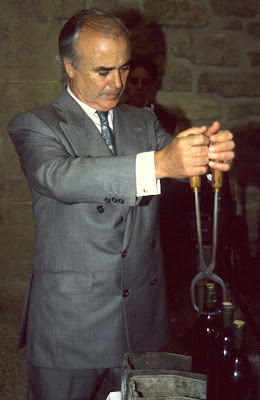On a warm sunny June day in the Basque Country, I drove down from Bilbao to Laguardia in La Rioja Alavesa for what promised to be a very special afternoon. Along with some 300 people, including local dignitaries, the Spanish national press, and a group of top Spanish and foreign wine writers and tasters, I had been invited to attend the unveiling of the maqueta (model) for Frank Gehry’s newest project in Spain, a multi-use building at Bodegas Marqués de Riscal, La Rioja’s oldest winery, which is located in the sleepy little Rioja Alavesa wine village of Elciego. Marqués de Riscal contracted Frank O. Gehry & Associates to build a shining futuristic hotel building on a grassy plot above the cluster of old winery buildings, some of which date from 1860. Riscal wanted a building that, according to winery sources, "breaks drastically with the image of the traditional Rioja cellar." The wine professionals were also invited to arrive at 5 p.m. to taste some stunning old wines from Marqués de Riscal’s cellars going back to 1871.
Paco Hurtado, Technical Director of Marqués de Riscal, opening a 1945 Reserva at an
event announcing the unveiling of Frank Gehry's plans for Riscal's futuristic hotel.
event announcing the unveiling of Frank Gehry's plans for Riscal's futuristic hotel.
On the way down to Riscal, I had lunch at Castillo el Colmado, a refurbished 1920s mansion situated on an esplanade along the northeastern edge of Laguardia, the dramatically-situated walled town that is to La Rioja what Riquewihr is to Alsace, Châteaunuef-du-Pape is to the Rhône. For Javier Arcillona, the tall, gaunt, very serious man who owns this charming, hotel-cum-restaurant, being a hotelier is a dream come true and he takes his mission seriously, attending to each table by advising guests of the daily specials, explaining dishes, and taking the orders himself. My luncheon companion was an old friend and fellow americano Thomas Perry, who is the Director of the Grupo de Exportadores de Vinos de La Rioja.
First, Sr. Arcillona sent out tapas of deep-fried, cured-ham croquetas, then a degustación of chef Manuel Rementería’s specialties. The procession of dishes included buttery, house-made pate de foie-gras; a typical Basque dish, revueltos con perritxos (scrambled eggs with prized spring mushrooms); braised pimientos de piquillo (the superb triangular-shaped red peppers of southern Rioja and Navarra); pencas de acelgas con crema (chard stalks in a creamy sauce); hojaldre de mejillones con salsa de erizos (mussels in puff pastry with a sea urchin sauce); and rich mushroom-filled crêpes. The ripe, juicy, Bordeaux-esque Dominio de Conte Reserva 1996 drank very well with these dishes and with my main course, a delicious, tender cabrito asado (roast suckling goat) with roasted potatoes.
While we were having lunch, a big thunderstorm swept along the northern rim of the Sierra de Cantabrica, the steep blue-gray wall that protects the Rioja from some of the fiercer winter storms from the wild Bay of Biscay, an hour to the north. There were huge black clouds with lightning and, probably somewhere over the vineyards of the surrounding La Rioja Alavesa (Basque Rioja), there could have been a hailstorm. At the very least the pelting rain could be wreaking havoc with the just-set flowering of the vines.
Contino Estate
The Contino estate vineyards.
Once, in late 1970s, I was visiting Contino estate in La Rioja in early July, when a ferocious storm hit, dumping tons of mothball-sized hail on the vineyards. The hail wiped out 65% of the Viñedos de Contino’s crop that year. There was so many hailstones that Basilio Izquierdo, the then winemaker at CUNE (who also owns Contino), and I used a pile of them to ice down a bottle of manzanilla that I had brought from Sanlúcar de Barrameda in Andalucía’s Sherry country. Here, in La Rioja, as in Burgundy and other regions at the limits of cultivation, nature threatens the vineyards, but it also blesses them with one of best climates on earth for making great wines.








No comments:
Post a Comment